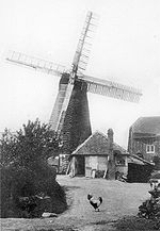
Pratt's Mill, Crowborough
Encyclopedia
Pratt's Mill is a tower mill
at Crowborough
, Sussex
, England
which has been truncated and converted to residential accommodation.
, RA
painted the mill when it was without sails and fantail. The picture appears in an early book on windmills. In 1927 the mill was converted into residential accommodation, being reduced in height to three storeys.
and the Kentish style cap was winded by a fantail
. All that remains today is the lower three storeys of the tower, with various additions and extensions. Hemming states that the mill may have driven three pairs of millstone
s.
Tower mill
A tower mill is a type of windmill which consists of a brick or stone tower, on top of which sits a roof or cap which can be turned to bring the sails into the wind....
at Crowborough
Crowborough
The highest point in the town is 242 metres above sea level. This summit is the highest point of the High Weald and second highest point in East Sussex . Its relative height is 159 m, meaning Crowborough qualifies as one of England's Marilyns...
, Sussex
Sussex
Sussex , from the Old English Sūþsēaxe , is an historic county in South East England corresponding roughly in area to the ancient Kingdom of Sussex. It is bounded on the north by Surrey, east by Kent, south by the English Channel, and west by Hampshire, and is divided for local government into West...
, England
England
England is a country that is part of the United Kingdom. It shares land borders with Scotland to the north and Wales to the west; the Irish Sea is to the north west, the Celtic Sea to the south west, with the North Sea to the east and the English Channel to the south separating it from continental...
which has been truncated and converted to residential accommodation.
History
Pratt's Mill was built between September 1861 and February 1862. The machinery from Calverley Mill, Tunbridge Wells was used in the construction of the mill. On 3 February 1862 the son of the miller was killed when he became entangled in the machinery. The mill was working by wind until 1907 and then by steam until 1922. Frank BrangwynFrank Brangwyn
Sir Frank William Brangwyn RA RWS RBA was an Anglo-Welsh artist, painter, water colourist, virtuoso engraver and illustrator, and progressive designer.- Biography :...
, RA
Royal Academy
The Royal Academy of Arts is an art institution based in Burlington House on Piccadilly, London. The Royal Academy of Arts has a unique position in being an independent, privately funded institution led by eminent artists and architects whose purpose is to promote the creation, enjoyment and...
painted the mill when it was without sails and fantail. The picture appears in an early book on windmills. In 1927 the mill was converted into residential accommodation, being reduced in height to three storeys.
Description
As built, Pratt's Mill was a five storey brick tower mill clad in peg tiles. It had four Patent sailsWindmill sail
Windmills are powered by their sails. Sails are found in different designs, from primitive common sails to the advanced patent sails.-Jib sails:...
and the Kentish style cap was winded by a fantail
Windmill fantail
A Fantail is a small windmill mounted at right angles to the sails, at the rear of the windmill, and which turns the cap automatically to bring it into the wind. The fantail was patented in 1745 by Edmund Lee, a blacksmith working at Brockmill Forge near Wigan, England, and perfected on mills...
. All that remains today is the lower three storeys of the tower, with various additions and extensions. Hemming states that the mill may have driven three pairs of millstone
Millstone
Millstones or mill stones are used in windmills and watermills, including tide mills, for grinding wheat or other grains.The type of stone most suitable for making millstones is a siliceous rock called burrstone , an open-textured, porous but tough, fine-grained sandstone, or a silicified,...
s.
External links
- Photograph of mill 1890
- Postcard of mill 1905
- Another postcard c.1905
- Mill and pond 1912
- Painting by Frank Brangwyn 1923

